article_detail
Murcia Capital, Lunes Santo, the barrio of San Antolin
Lunes Santo, Holy Monday, Murcia
The Barrio of san Antolin
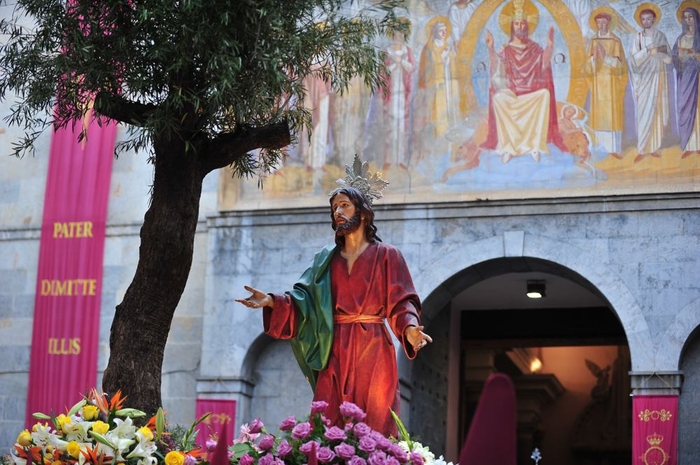
It´s a surprise to many visitors to the Region of Murcia to learn that this was once a thriving centre of silk production.
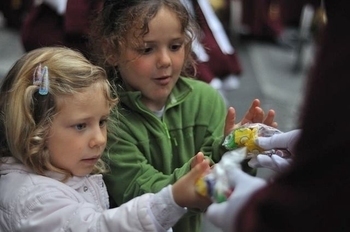 Murcia was a Moorish City, it´s strong walls and structure built by the Moors on the banks of the river, providing irrigation, protection and rich soil on which to build a thriving agricultural economy, with strong links into the Mediterranean trade routes out along the Mediterranean basin throughout Africa and on into the Middle East.
Murcia was a Moorish City, it´s strong walls and structure built by the Moors on the banks of the river, providing irrigation, protection and rich soil on which to build a thriving agricultural economy, with strong links into the Mediterranean trade routes out along the Mediterranean basin throughout Africa and on into the Middle East.
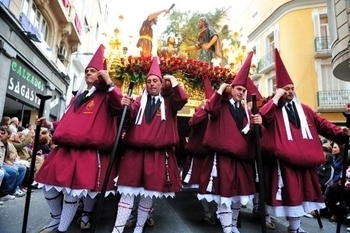 The climate here was perfect for silk worm cultivation, and a great deal of production was centred in Murcia and the outlying areas known as the huertos, the orchards, irrigated and cultivated intensively.
The climate here was perfect for silk worm cultivation, and a great deal of production was centred in Murcia and the outlying areas known as the huertos, the orchards, irrigated and cultivated intensively.
Of course, much of what we now see as the capital of Murcia was agricultural land during this era, although 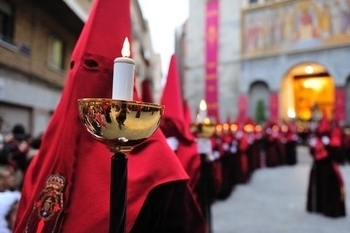 vast areas of the Moorish city lie beneath the streets of modern Murcia, such as the zone of San Esteban where works to build a carpark revealed a large Moorish residential area, the intention being to develop the site as a musuem in the future when financing becomes available.
vast areas of the Moorish city lie beneath the streets of modern Murcia, such as the zone of San Esteban where works to build a carpark revealed a large Moorish residential area, the intention being to develop the site as a musuem in the future when financing becomes available.
There are traces of both the Moorish occupation and also the silk production industry in many places within 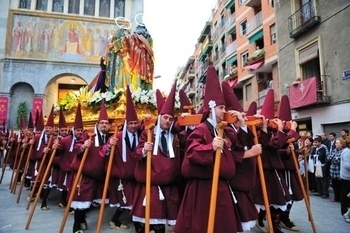 the Murcia municipality, with a surprising number of traditions based around the whole production process of silk.
the Murcia municipality, with a surprising number of traditions based around the whole production process of silk.
If you´re interested in finding out more, the Museo de la Ciudad is a good place to start, as it has a static exhibit relating to the silk making process, as well as an area dedicated exclusively to the birth of Medina Mur-siya, now the City of Murcia( ask at reception for an English language brochure, and youll find the guide also speaks English).
Another good place to see photos relating to silk production is up in the Sanctuary of La Luz on the outskirts of the City in the El Valle y Carrascoy regional park which fringes Murcia: the visitor centre has a whole section dedicatde to the silk industry and theres an excellent lunch on offer at the centre with fabulous views across the Segura valley and city below.
Another good place is the Museo Salzillo, where some of the original embroidered silks worn in the religious 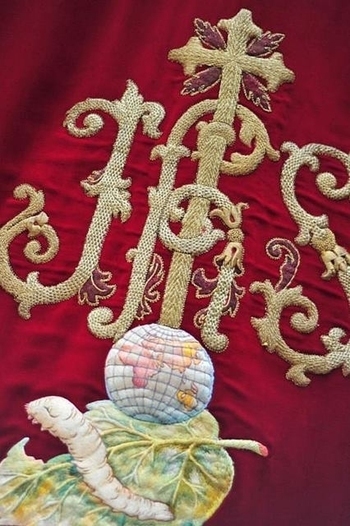 processions are on display, fine examples of the silk produced here in the City and relating directly to the acts of Semana Santa and the explosion of baroque splendour constructed in the city, fuelled by the wealth of the silk industry.
processions are on display, fine examples of the silk produced here in the City and relating directly to the acts of Semana Santa and the explosion of baroque splendour constructed in the city, fuelled by the wealth of the silk industry.
The district of San Antolin was at the heart of the silk industry, the home of the master weavers who produced the finished product which brought so much revenue to the city.
This procession was once known as the procession of the trains, as such was the wealth of this area that the penitents would parade with 2 metre long trains of silk behind them, a statement of prestige and wealth.
With time, and as the number of penitents increased, it became impractical to drag a train of this length, so  the trains were reduced in length and today have disappeared altogether, the penitents wearing standard length tunics.
the trains were reduced in length and today have disappeared altogether, the penitents wearing standard length tunics.
Those witnessing a Murcian procession for the first time will be astonished by the difference in both style and character of these processions from one seen, for example, in Cartagena.
The tunics of these penitents are bulging grotesquely with food, sweets, mona de pascua, boiled eggs and bread, food they share generously with onlookers, and as this parade is a good 4 hours long, many thousands of hands will be held aloft asking for sweets and treats, so the penitents stock up well for the journey ahead.
As with many things Murcian, food is the centre of all celebrations, and the giving and sharing of food is a 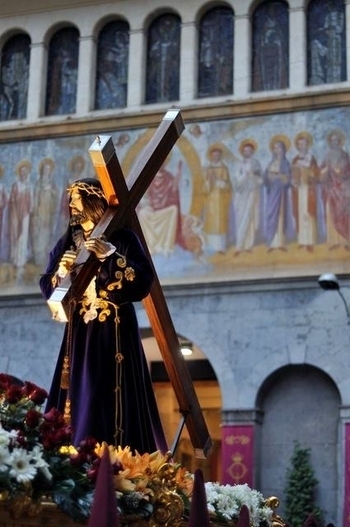 quintessential part of the Murcian Semana Santa.
quintessential part of the Murcian Semana Santa.
The whole atmosphere is lighter, although this an act of holy penitence, it´s also a celebration of Christs sacrifice and as with all things Murcian is undertaken with humour and character, interaction with the crowds a core fundamental act, unlike the more austere nature of acts undertaken in other locations.
The shorter tunics which are belted to enable penitents to carry these vast bulks of food, leave legs exposed, revealing hand crocheted stockings, made in this traditional fashion for centuries.
Some of the brotherhoods were wearing black stockings instead of some of the more commonly seen white ones, and it was explained that these are representative of some of the older orders, some of the more 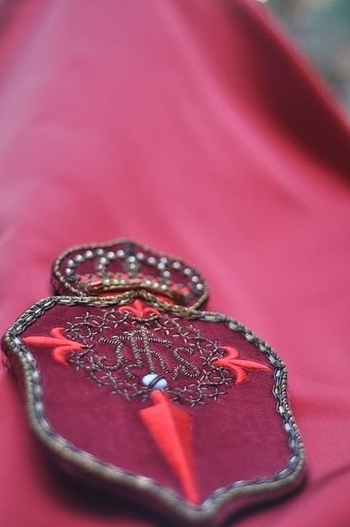 historical brotherhoods wearing black, which was the traditional colour for legwear of this nature. In the days before Daz super white washing powder, black was an infinitely more practical everyday colour for the man in the street to wear than white, so only the very wealthy could afford to dazzle with their white stockings.
historical brotherhoods wearing black, which was the traditional colour for legwear of this nature. In the days before Daz super white washing powder, black was an infinitely more practical everyday colour for the man in the street to wear than white, so only the very wealthy could afford to dazzle with their white stockings.
Some of these "stockings" are embroidered with further "badges " defining their loyalties further, so you´ll see specific patterns and designs embroidered, symbols of the Cofradías, or flowers, and yet more symbolism is defined by the garters worn around the legs of others.
Also of note is the footwear, traditional espadrillas which were manufactured so extensively in this region. Caravaca de la Cruz and the North of the Region were notable centres for the production of these handmade 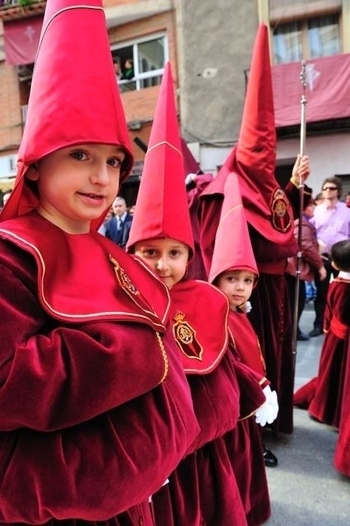 shoes, as esparto, the core component for the footwear, grew extensively in these areas. Thousands of shoes would be produced in these areas and shipped down to the capital for sale, the trade route from the north, now slowly becoming a pilgrimage route from the capital to the far reaches of the region.
shoes, as esparto, the core component for the footwear, grew extensively in these areas. Thousands of shoes would be produced in these areas and shipped down to the capital for sale, the trade route from the north, now slowly becoming a pilgrimage route from the capital to the far reaches of the region.
If ever you´re in Caravaca de la Cruz, visit the tiny museum created by one man, Angel Reinon, the Museo Etnografico en Miniatura, which shows the processes of espadrilla production in miniature, this amazing man having produced miniature reproductions of tools and machinery used historically in the region. It really is a remarkable little museum, and has some large photographs showing esparto footwear production
 Just a minimum of participants wear the white leather shoes and intricate hand made lace ruffs of the Mayordomos of the Cofradía, leather footwear a symbol of status, a privilege granted to only two or three people per Cofradía.
Just a minimum of participants wear the white leather shoes and intricate hand made lace ruffs of the Mayordomos of the Cofradía, leather footwear a symbol of status, a privilege granted to only two or three people per Cofradía.
This is a good sized procession with over 2000 penitents and 10 pasos.
Sadly 8 pasos left the church, accompanied by the distinctive throb of Murcian drums, before the rain set in and the precious pasos were covered with plastic and returned home, too priceless to expose to the elements and risk damage.
Unfortunately, the most important Paso of all, that of the Stmo. Cristo del Perdon, with sculptures by Salzillo and Roque López, was unable to do more than go out of the church and turn in a circle to tumultuous applause before being brought back inside to protect it from the rain, its bearers distraught after a year of hard work to prepare for this one procession.
 Other important processions are still to come: the Coloraos filing across the river in a seeping stain of red on Wednesday, the Procesión de los Salzillos on Friday morning and the day of resurrection when white and light celebrate the end of mourning and the joy of eternal life.
Other important processions are still to come: the Coloraos filing across the river in a seeping stain of red on Wednesday, the Procesión de los Salzillos on Friday morning and the day of resurrection when white and light celebrate the end of mourning and the joy of eternal life.
article_detail
Contact Spanish News Today: Editorial 966 260 896 /
Office 968 018 268













